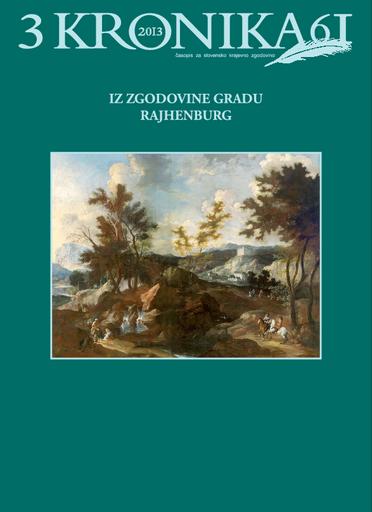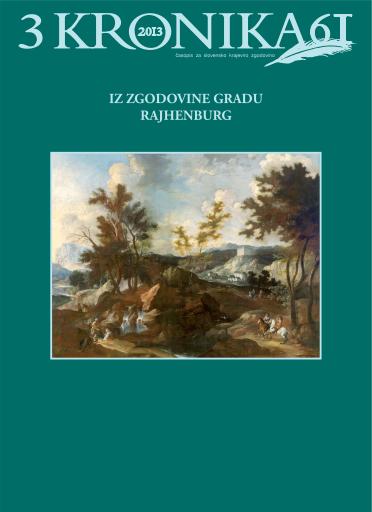/
Serijske publikacije
/
Kronika: časopis za slovensko krajevno zgodovino
Poslikana renesančna sobana v gradu Rajhenburg

Avtor(ji):Simon Menoni
Soavtor(ji):Miha Preinfalk (odg. ur.), Barbara Šterbenc Svetina (teh. ur.), Alenka Cizel (prev.), Manca Gašperšič (prev.), Andreja Jankovič Deržič (prev.), Dejan Zadravec (prev.), Lidija Slana (prev.), Meta Osredkar (prev.), Agencija MultiLingual (prev.), Irena Bruckmüller Vilfan (prev.)
Leto:2013
Založnik(i):Zveza zgodovinskih društev Slovenije, Ljubljana
Vir(i):Kronika, 2013, št. 3
Jezik(i):slovenščina
Vrst(e) gradiva:besedilo
Ključne besede:grad Rajhenburg, stenska poslikava, renesansa, renesančne freske, krščanske kreposti, Suzanina legenda, Salomonova razsodba, profano stensko slikarstvo, Rajhenburg Castle, mural painting, Renaissance, Renaissance frescoes, Christian virtues, legend of Susanna, Solomon’s judgement, profane mural painting
Avtorske pravice:

To delo avtorja Simon Menoni je ponujeno pod Creative Commons Priznanje avtorstva-Nekomercialno-Brez predelav 4.0 Mednarodna
Datoteke (1)

Ime:kronika-2013_3.pdf
Velikost:66.73MB
Format:application/pdf
Stalna povezava:https://hdl.handle.net/11686/file18349
Opis
Na slikoviti legi na vzpetini nad Savo stoji grad Rajhenburg, ki ga ob stavbnozgodovinskih kvalitetah odlikuje
tudi imenitna renesančna poslikava v trikotni sobani v prvem nadstropju vzhodnega trakta. Ta predstavlja eno
izmed redkih ohranjenih prič profanega stenskega slikarstva na Slovenskem iz obdobja 16. stoletja. Obsega
poslikavo vseh sten kot tudi nišo ob oknu na severni steni. V manjšem okenskem prostoru nasproti vhoda sta komaj
razpoznavna prizora iz Kristusovega pasijona, Zadnja večerja in Kristus na Oljski gori. Poslikava na severni
steni kaže skupino štirih personifikacij krščanskih kreposti – Iustitia, Fortitudo, Spes, Temperantia. Na zahodnem
delu severne stene je skupina treh dvorjanov, levo od skupine pa še bradati mož. Na južni steni sta ločena prizora,
Suzana iz Danijelove knjige in domnevna Salamonova sodba. Slogovno so freske delo enega od slikarjev iz
delavnice mojstra, ki je leta 1526 poslikal cerkev v Marija Gradcu in datirajo v čas tretjega desetletja 16. stoletja.
Metapodatki (12)
- identifikatorhttps://hdl.handle.net/11686/34997
- naslov
- Poslikana renesančna sobana v gradu Rajhenburg
- Frescoes in the Renaissance hall of the Rajhenburg Castle
- ustvarjalec
- Simon Menoni
- soavtor
- Miha Preinfalk (odg. ur.)
- Barbara Šterbenc Svetina (teh. ur.)
- Alenka Cizel (prev.)
- Manca Gašperšič (prev.)
- Andreja Jankovič Deržič (prev.)
- Dejan Zadravec (prev.)
- Lidija Slana (prev.)
- Meta Osredkar (prev.)
- Agencija MultiLingual (prev.)
- Irena Bruckmüller Vilfan (prev.)
- predmet
- grad Rajhenburg
- stenska poslikava
- renesansa
- renesančne freske
- krščanske kreposti
- Suzanina legenda
- Salomonova razsodba
- profano stensko slikarstvo
- Rajhenburg Castle
- mural painting
- Renaissance
- Renaissance frescoes
- Christian virtues
- legend of Susanna
- Solomon’s judgement
- profane mural painting
- opis
- Na slikoviti legi na vzpetini nad Savo stoji grad Rajhenburg, ki ga ob stavbnozgodovinskih kvalitetah odlikuje tudi imenitna renesančna poslikava v trikotni sobani v prvem nadstropju vzhodnega trakta. Ta predstavlja eno izmed redkih ohranjenih prič profanega stenskega slikarstva na Slovenskem iz obdobja 16. stoletja. Obsega poslikavo vseh sten kot tudi nišo ob oknu na severni steni. V manjšem okenskem prostoru nasproti vhoda sta komaj razpoznavna prizora iz Kristusovega pasijona, Zadnja večerja in Kristus na Oljski gori. Poslikava na severni steni kaže skupino štirih personifikacij krščanskih kreposti – Iustitia, Fortitudo, Spes, Temperantia. Na zahodnem delu severne stene je skupina treh dvorjanov, levo od skupine pa še bradati mož. Na južni steni sta ločena prizora, Suzana iz Danijelove knjige in domnevna Salamonova sodba. Slogovno so freske delo enega od slikarjev iz delavnice mojstra, ki je leta 1526 poslikal cerkev v Marija Gradcu in datirajo v čas tretjega desetletja 16. stoletja.
- The Rajhenburg Castle, occupying a picturesque location on a hill above the Sava River, distinguishes itself by its outstanding historical architectural features as well as by the magnificent Renaissance frescoes in the triangular hall on the first floor of the eastern tract. The latter are among the rare preserved witnesses to the 16th-century profane mural painting in the Slovenian territory. The artwork covers all the walls, including the window niche in the northern wall. The small window area opposite the entrance features the barely discernible scenes from the Passion of Christ – the Last Supper and Christ on the Mount of Olives. The fresco on the northern wall depicts a group of four personifications of Christian virtues – Iustitia, Fortitudo, Spes, Temperantia. The western portion of the northern wall features a group of three courtiers and a bearded man to their left. The southern wall depicts two separate scenes – Susanna from the Book of Daniel and what could be Solomon’s Judgement. Stylistically, the frescoes are the work of a painter from the workshop of the master who painted the church at Marija Gradec in 1526 and date back to the third decade of the 16th century.
- The Rajhenburg Castle has long been at the centre of scholarly interest, primarily due its outstanding historical architectural features, but also because of the magnificent frescoes in the triangular hall on the first floor of the eastern tract, which are among the rare preserved witnesses to the 16thcentury profane mural painting in the Slovenian territory. The artwork covers all the walls, including the window niche in the northern wall, featuring the barely discernible scenes from the Passion of Christ, the Last Supper in the eastern and Christ on the Mount of Olives in the western portion. The fresco on the northern wall left of the window niche, depicts an interesting group of four personifications of Christian virtues – Iustitia (preserved only with the title band and attribute), Fortitudo, Spes, Temporantia – continuing in the western section of the northern wall with a group of three courtiers engaged in what seems to be a leisurely conversation. Left of the group is a bearded man, set apart from the others by a painted pillar, and one cannot help but wish to recognise in this noble crowd the Habsburg Emperor Maximilian I, accompanied by his first wife Mary of Burgundy or, more likely, the beautiful Bianca Maria Sforza, and the more distant figure as the Rajhenburg’s most important representative Reinprecht. The entire western wall used to be covered by more frescoes, which have been almost completely destroyed. The southern wall depicts two separate scenes, the presumed Solomon’s Judgement and the wrongful condemnation of virtuous Susanna from the Book of Daniel. According to the first iconographic study of the frescoes at Brestanica, both scenes should be identified with the legend of Emperor Henry and Empress Cunigunde, but the paper at hand rejects this proposal. We do, however, agree that the selected scenes undoubtedly belong to the so-called righteous depictions, which led previous authors to identify the place as a courtroom – a function such a small room with sophisticated frescoes comprehensible only to a savvy observer, as well as a room standing adjacent to private representative halls could by no means have. Owing to the latter, one should perhaps also have in mind that the procurer must have had an education in the humanities and used this space as a Renaissance studio. Whereas in the current stage of research, we admittedly continue to place the Brestanica frescoes into loosely the third decade of the 16th century, we certainly have no difficulties in identifying their stylistic features. They are the work of a painter from the workshop of the master who in 1526 painted the church at Marija Gradec. Drawing on analogies with the art of the Dürer period, the latter came to Slovenian Styria from artistically more advanced and prosperous Austrian Carinthia and Styria. The author of the Renaissance frescoes in the hall of the Rajhenberg Castle narrowed down the broad range of facial types used by the master of Marija Gradec, but preserved his sense of balanced composition. In this connection, it should also be pointed out that the painter at Rajhenburg never attained the artistic accomplishment of the master of Marija Gradec, with his main deficiency being in depicting arms and legs, as well as human proportions. Nevertheless, he compensated for his weakness with a monumental presentation of figures that evoke the new Renaissance spirit. Thus, he demonstrated a great aptitude for merging numerous architectural and decorative elements with figural scenes, without robbing the latter of narrative power, and an even greater aptitude for progressive stylistic vision. Due to the latter, he left no trace in his frescoes of the late-Gothic tradition and conservatism, from which the painter of Marija Gradec could not completely depart.
- založnik
- Zveza zgodovinskih društev Slovenije
- datum
- 2013
- tip
- besedilo
- jezik
- Slovenščina
- jeDelOd
- pravice
- licenca: ccByNcNd
